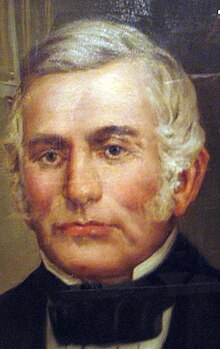Missouri Executive Order 44

Missouri Executive Order 44 , also known as the Mormon Extermination Order , is an ordinance in Mormon history issued on October 27, 1838 by Missouris Governor Lilburn Boggs . It was enacted after the Battle of the Crooge River in the Mormon War in 1838, following a dispute between Mormons and a state militia. The governor insisted that the Mormons had openly and deliberately opposed the law and waged war against the citizens of the state and should therefore be treated as enemies and exterminated or driven from the state. Although the ordinance was known as the Mormon Extermination Ordinance, relatively few people lost their lives. But the state militias used the ordinance as a reason to evict the Mormons from their Missouri lands and force them to immigrate to Illinois . The Mormons did not return to Missouri until 25 years later when they found a more benevolent environment in which to build houses. In 1976, because of its unconstitutionality, the ordinance was formally abolished by then-governor Missouris Kit Bond .
background
This ordinance was issued by the governor of Missouris during the Mormon War of 1838, caused by the tension between Mormons and their neighbors over the growing economic and political power of the Mormons and the public opposition to slavery by the Mormons. The war ended with the displacement of almost all Mormons from Missouri. The Mormons were granted a county that soon became too small because of the onslaught of converts. On July 4, 1838, Mormon leader Sidney Rigdon gave a speech in which he called for Mormon self-defense. This added to the tension. The non-Mormons in Missouri believed that a Mormon invasion of their state was imminent. This notion was further fueled by the Danites when they attacked a village. News of a battle for the Crooge River and the behavior of the Danites in the capital Missouri resulted in a very tense situation, in the context of which the extermination order is to be seen.
Text of the regulation
The regulation reads as follows:
Headquarters of the Militia, City of Jefferson, Oct. 27, 1838.
Gene. John B. Clark:
Sir: Since the order of this morning to you, directing you to cause four hundred mounted men to be raised within your division, I have received by Amos Reese, Esq., Of Ray county, and Wiley C. Williams, Esq., One of my aids, information of the most appalling character, which entirely changes the face of things, and places the Mormons in the attitude of an open and avowed defiance of the laws, and of having made war upon the people of this state. Your orders are, therefore, to hasten your operation with all possible speed. The Mormons must be treated as enemies, and must be exterminated or driven from the state if necessary for the public peace - their outrages are beyond all description. If you can increase your force, you are authorized to do so to any extent you may consider necessary. I have just issued orders to Maj. Gen. Willock, of Marion county, to raise five hundred men, and to march them to the northern part of Daviess, and there unite with Gen. Doniphan, of Clay, who has been ordered with five hundred men to proceed to the same point for the purpose of intercepting the retreat of the Mormons to the north. They have been directed to communicate with you by express, you can also communicate with them if you find it necessary. Instead therefore of proceeding as at first directed to reinstate the citizens of Daviess in their homes, you will proceed immediately to Richmond and then operate against the Mormons. Brig. Gen. Parks of Ray, has been ordered to have four hundred of his brigade in readiness to join you at Richmond. The whole force will be placed under your command.
I am very respectfully, yr obt st [your obedient servant],
LW Boggs, Commander-in-Chief.
Aftermath and formal cancellation
Although the ordinance was technically no longer carried out when the Mormons surrendered in Far West on November 1, many Mormons (approximately 10,000) were evicted from Missouri because of the ordinance and had to flee with what was on their bodies.
A non-Mormon lawmaker, David Rice Atchison , refused to live in a state where Mormons are discriminated against.
The ordinance was formally repealed by Governor Kit Bond on June 25, 1976. The communion of Christ then invited him to a conference at which he reaffirmed his friendly intentions.
Further literature
Web links
- Mormon War Letters , the war correspondence that led to the Destruction Ordinance
- The Missouri Mormon War Executive Orders , the original ordinance

